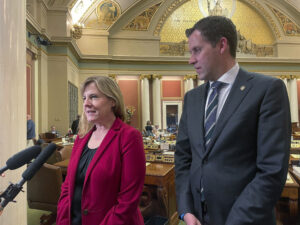Get Ready for a More Conservative Supreme Court
Here is an unsettling thought for those who waited eight years to have a Democratic president appointing judges: Barack Obama could well end his first term with a more conservative Supreme Court than the one he inherited.Here is an unsettling thought for those who waited eight years to have a Democratic president appointing judges: Barack Obama could well end his first term with a more conservative Supreme Court than the one he inherited.
This is, I hasten to admit, premature speculation — even with the not-so-surprise announcement that Justice John Paul Stevens, the anchor of the court’s liberal wing, is retiring.
First, the president’s only nominee so far, Justice Sonia Sotomayor, has not even finished her first term. Where she turns out to be on the ideological spectrum in comparison to the justice she replaced, David Souter, is unknown.
Second, the accuracy of this conjecture will depend hugely on whom the president selects to fill the Stevens vacancy.
Finally, as the examples of Souter (named by President George H.W. Bush) and Stevens (selected by President Gerald Ford) demonstrate, predictions about a new justice’s future performance can make weather forecasting look like an exact science.
Nonetheless, it’s entirely possible that a more conservative court could be Obama’s paradoxical legacy — particularly if he serves only a single term. The likelihood of the court shifting to the right is greater than that of its moving leftward.
In part, this could have been predicted even before Obama took office. It reflects less about him than it does the identity of the departing justices, one liberal followed by another. The next oldest justice is Ruth Bader Ginsburg, 77. Conservatives are reaping the benefits of Bush father and son having selected justices who were relatively young. Justice Clarence Thomas was 43 when tapped, Chief Justice John Roberts was 50, and Justice Samuel Alito was 55.
It would likely only be in the case of a departure by 74-year-old Justice Antonin Scalia — not likely to occur voluntarily during Obama’s presidency — or Justice Anthony Kennedy, 73, that the president would have an opportunity to dramatically alter the court’s ideological makeup.
But there’s little in Obama’s record as president to suggest that he would expend enormous capital to secure the most liberal possible justice. From the point of view of liberal groups, Obama’s nominees to the lower federal courts have been, overall, disappointingly moderate.
In selecting Sotomayor, Obama acted with an eye less to ideology than to ethnicity; the selection does not offer much of a clue into what the president is looking for, as a matter of constitutional interpretation, in future justices. The conservative howling about Sotomayor’s alleged radicalism had as little basis in reality as do the parallel assertions about Obama.
As Tom Goldstein of ScotusBlog put it after analyzing Sotomayor’s appellate record, “Our surveys of her opinions put her in essentially the same ideological position as Justice Souter.” From her conduct on the bench so far, there’s no reason to change that assessment.
By contrast, it’s likely, although not certain, that a Stevens replacement will be more conservative than the retiring justice. If so, this would be largely in line with history. In an interview with Jeffrey Rosen for The New York Times Magazine in 2007, Stevens noted, “including myself, every judge who’s been appointed to the court since Lewis Powell (chosen by Richard Nixon in 1971) has been more conservative than his or her predecessor.” Stevens excepted Ginsburg, who replaced the more conservative Byron White.
In any event, Stevens’ replacement is almost certain not to be as influential a player on the left as the departing justice. As the court’s senior associate justice, Stevens spoke immediately after the chief justice during the court’s discussion of cases; he had the power to assign opinions and some influence with swing justices such as Kennedy and, before her departure, Sandra Day O’Connor.
I’m not arguing, by the way, that Obama would go wrong by picking a Stevens successor likely to edge the court to the right. Indeed, there is a plausible argument that a justice viewed as more centrist might have more chance of bringing along conservative colleagues on a particular issue. Two of those mentioned as possible replacements, Judge Merrick Garland of the federal appeals court in the District of Columbia and Solicitor General Elena Kagan, are viewed as more moderate than Stevens. Either would be a superb choice.
But my prediction stands: The court that convenes on the first Monday in October is apt to be more conservative than the one we have now.
Ruth Marcus’ e-mail address is marcusr(at symbol)washpost.com.
© 2010, Washington Post Writers Group
Your support matters…Independent journalism is under threat and overshadowed by heavily funded mainstream media.
You can help level the playing field. Become a member.
Your tax-deductible contribution keeps us digging beneath the headlines to give you thought-provoking, investigative reporting and analysis that unearths what's really happening- without compromise.
Give today to support our courageous, independent journalists.






You need to be a supporter to comment.
There are currently no responses to this article.
Be the first to respond.